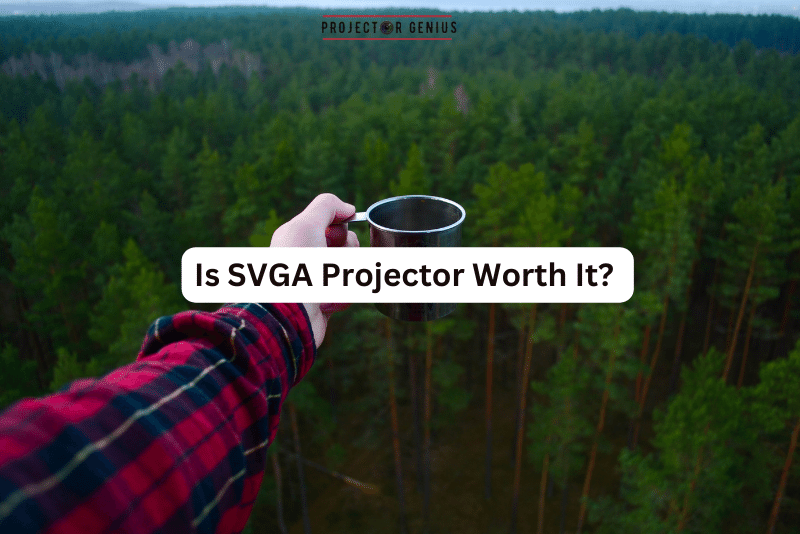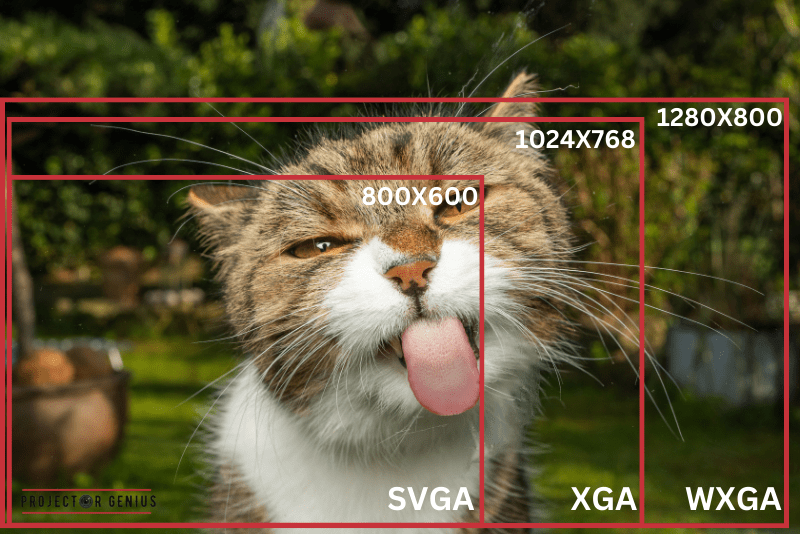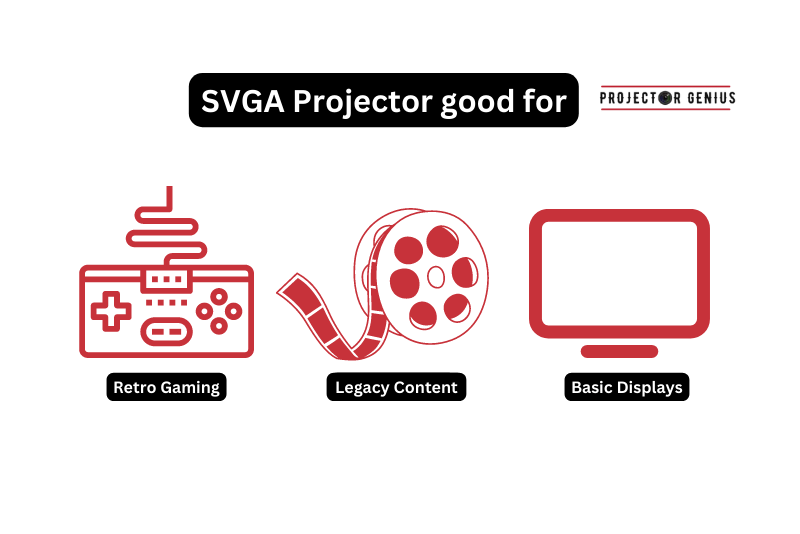Is SVGA Projector Worth It?
-
 Written by:
Kristy Roger
Written by:
Kristy Roger
- Last Updated:

So you are wondering “is SVGA Projector Worth It?” And you’ve come to the right place.
Choosing the best is difficult, I know! Fortunately, I’ve spent several years researching and studying projector video production and have managed to narrow it down for you.
During this time, I’ve had hands-on experience with hundreds of different projector types. Let’s dive into the pros and cons to help you decide: Is an SVGA Projector Worth It?
I’ll also help you decide which Resolution works best for you.
Is SVGA Projector Worth It? Whether an SVGA projector is worth it depends on your specific needs and budget. SVGA projectors offer lower resolution compared to higher-end models, so they may not be suitable for detailed presentations or high-definition content. However, if you have basic projection needs and are on a tight budget, an SVGA projector can still provide decent image quality for simple tasks like PowerPoint presentations or watching standard-definition videos.
I recommend using the Table of Contents to quickly access the information you need.
My article is designed to cater to home cinema users of all levels, from Beginners to Advanced enthusiasts.
Table of Contents
Should You Go for a SVGA projector? Let’s Find Out
Let’s explore whether going for an SVGA projector is the right choice for you:
An SVGA projector with its 800×600 pixel resolution can be suitable for smaller settings, like classrooms or basic presentations. It comes at a more budget-friendly price point, making it accessible for certain needs.
However, it’s essential to consider that technology has evolved, and higher resolutions like 1080p and 4K offer significantly better image clarity and detail. Most modern content, such as YouTube videos, Netflix TV shows and movies, and new gaming releases, is designed for these higher resolutions.
If you prioritize the best possible visual experience and compatibility with today’s media standards, investing in a projector with a higher resolution might be a wiser choice. While SVGA projectors have their place, especially for simpler setups, your decision should align with your intended use and your desire for optimal image quality.
What is an SVGA Projector?
An SVGA projector is a type of video projector that supports the SVGA (Super Video Graphics Array) resolution standard. SVGA is a lower resolution compared to modern standards, but it was popular in the past and is still used in some applications.
SVGA resolution typically refers to a display resolution of 800 x 600 pixels, resulting in a total of 480,000 pixels on the screen. While this resolution might seem quite low compared to today’s standards, SVGA projectors were commonly used for presentations, classrooms, and small-scale projections where high-definition detail wasn’t a primary concern.
SVGA projectors were popular in the late 1990s and early 2000s when higher resolutions like XGA (1024 x 768) and SXGA (1280 x 1024) started becoming more common. As technology advanced, resolutions such as Full HD (1920 x 1080) and even 4K (3840 x 2160) became the new standards for projectors, providing much higher image quality and detail.
Today, SVGA projectors are somewhat outdated and are typically used in situations where cost is a significant factor and high-definition image quality is not a priority. They might still be found in some educational settings, small businesses, or places with budget constraints.
If you want to learn more, read my comprehensive comparison of WXGA vs XGA vs SVGA.
What are the Benefits of Choosing an SVGA Projector?
In this post, we will discuss the benefits of choosing an SVGA projector and whether it is the best choice for particular scenarios.
Affordability
One of the standout advantages of an SVGA projector is its budget-friendly price point. If you’re seeking a projector solution without breaking the bank, an SVGA option can be a great fit.
Basic Presentations
If your primary use involves basic presentations, such as in classrooms or small meeting rooms, an SVGA projector can serve your needs well. It offers clear visuals for text and simple graphics.
Compact and Portable
SVGA projectors are often compact and lightweight, making them easy to transport and set up. This portability can be a significant advantage for on-the-go presentations.
Energy Efficiency
With a lower resolution, SVGA projectors require less processing power and energy to deliver visuals. This can result in longer lamp life and lower energy consumption.
Compatibility
Many devices, including older computers and some older content sources, are compatible with the SVGA resolution. This can be particularly useful if you’re working with legacy equipment.
Entry-Level Option
If you’re new to projectors and are looking to dip your toes into the world of projection technology, an SVGA projector provides a straightforward entry point.
Non-Critical Use
For situations where ultra-high image quality isn’t the top priority, such as displaying simple slides or basic videos, an SVGA projector can suffice.
In essence, choosing an SVGA projector brings affordability, simplicity, and compatibility to the forefront. It’s a practical choice for situations that don’t demand the highest image resolution but still require clear and presentable visuals. Whether you’re conducting educational sessions, small-scale presentations, or need a portable option, the benefits of an SVGA projector can fulfill your needs effectively.
What Challenges or Limitations Might I Face with an SVGA Projector?
Let’s explore the challenges and limitations that come with using an SVGA projector:
Limited Detail
The 800×600 pixel resolution of SVGA might not deliver the same level of image detail as higher resolutions, impacting visual clarity, especially for intricate content.
Modern Content Compatibility
While SVGA projectors can display today’s content, much of it is optimized for higher resolutions like 1080p and 4K, potentially affecting the intended visual quality.
Screen Size Constraint
SVGA projectors excel on smaller screens but might not offer the same image quality on larger projections.
Limited Future-Proofing
As technology advances, investing in an SVGA projector might not provide compatibility with the higher-resolution content of the future.
Professional Use
For visually demanding tasks like design work or presentations, the limitations of SVGA might hinder your ability to deliver impactful visuals.
Advancements in Technology
Considering the accessibility of higher resolutions, weighing the pros and cons of an SVGA projector is essential.
In summary, while an SVGA projector has its advantages, it’s important to recognize its limitations and consider whether it meets your needs in a world where higher resolutions dominate the visual landscape. Your decision should align with the quality of visuals you desire and your expectations for compatibility with modern content standards.
Feel free to read my comprehensive comparison of 480p vs SVGA.
How does SVGA Resolution Compare to Other Resolutions like XGA and Full HD?

SVGA resolution, at 800×600 pixels, is a standard that’s been around for a while. It’s known for providing basic visuals suitable for simple presentations, classrooms, and small-scale setups. However, when you step up to XGA resolution at 1024×768 pixels, you’re getting a noticeable bump in image detail. This resolution offers a clearer, crisper visual experience, making it great for more professional presentations and slightly larger screens.
Now, let’s talk about the leap to Full HD. At 1920×1080 pixels, Full HD offers a significantly higher level of image quality compared to both SVGA and XGA. The difference is remarkable – visuals are sharper, more vibrant, and closer to what you’d experience in a movie theater or high-end display. Full HD is perfect for enjoying content like YouTube videos, Netflix TV shows and movies, and immersive gaming.
In essence, SVGA resolution is the most basic of the three, suitable for simpler needs. XGA resolution takes you a step further with clearer visuals, making it suitable for more professional scenarios. However, if you’re seeking the best image quality, particularly for entertainment and detailed presentations, Full HD stands as the clear winner with its remarkable clarity and vibrant visuals.
So, as you decide on the right resolution, consider your intended use. If basic presentations in small settings suffice, SVGA might do the job. If you need better detail for professional settings, XGA offers an upgrade. But for the most impressive image quality and a rich visual experience, Full HD is the way to go.
Is an SVGA Projector Suitable for Modern Content and Presentations?
Choosing an SVGA projector for modern content and presentations requires some careful consideration. Let’s break down whether it’s a suitable choice.
When it comes to modern content, like YouTube videos, Netflix TV shows and movies, and even advanced graphics in presentations, an SVGA projector might fall short. The resolution of 800×600 pixels could impact the clarity and detail that modern content deserves. While it can display this content, it might not fully capture the immersive visual experience intended by creators.
For presentations, the suitability of an SVGA projector depends on the nature of your content and your audience. For simple text-based presentations in smaller settings, it can still deliver clear visuals. However, if your presentations involve complex graphics, high-resolution images, or if you’re aiming to make a lasting impression, the limitations of SVGA might hinder your efforts.
Additionally, consider the compatibility factor. Most devices and content today are designed with higher resolutions in mind. Opting for an SVGA projector might lead to compatibility challenges with modern laptops, devices, and content sources.
In summary, while an SVGA projector has its benefits, it’s important to weigh them against its limitations. If your content and presentations demand clear detail, vibrant visuals, and compatibility with modern devices, you might find that higher resolutions like XGA or Full HD offer a more suitable solution. As you make your decision, think about the level of impact you want to create and whether the technology aligns with your goals for engaging and effective presentations.
Will an SVGA Projector Provide a Clear and Enjoyable Viewing Experience?
Let’s talk about whether an SVGA projector can deliver a clear and enjoyable viewing experience. It’s an important consideration, so let’s dive in.
An SVGA projector with its 800×600 pixel resolution can provide a satisfactory viewing experience for certain scenarios. If you’re engaging in basic tasks like displaying simple slides or text-heavy presentations in smaller settings, it can certainly get the job done. The visuals might be clear enough for straightforward content.
However, when it comes to more visually demanding situations, like enjoying YouTube videos, Netflix TV shows and movies, or playing modern games, the limitations of SVGA become more evident. The lower resolution might not capture the finer details and vibrant visuals that these types of content offer.
For a truly enjoyable viewing experience, especially when immersing yourself in high-quality media, higher resolutions like Full HD offer a significant upgrade. They provide the level of image clarity and detail that truly enhances your visual journey.
So, while an SVGA projector can offer a clear experience for specific tasks, keep in mind its limitations when it comes to modern, visually rich content. If your aim is to fully enjoy the immersive quality of modern media, you might want to explore options with higher resolutions that can provide a more satisfying and engaging viewing experience.
Is SVGA Projector Worth It?
Let’s tackle the question: is an SVGA projector worth your investment? It’s a decision that depends on a few key factors, so let’s break it down.
If your usage involves basic presentations, text-heavy slides, or simple graphics in smaller settings, an SVGA projector can be a practical and budget-friendly choice. Its 800×600 pixel resolution can deliver clear visuals for these scenarios without breaking the bank.
However, when you venture into the realm of modern content, like YouTube videos, Netflix TV shows and movies, or advanced graphics in presentations, the limitations of SVGA resolution become more apparent. The visuals might not capture the full detail and vibrancy that higher resolutions offer.
When considering an SVGA projector, it’s essential to weigh the trade-offs. While it’s an accessible option for basic needs, it might not provide the best visual experience for modern, visually rich content. If your intention is to fully enjoy immersive media or make impactful presentations with high-quality graphics, you might find that a projector with a higher resolution, such as XGA or Full HD, offers a more satisfying solution.
Ultimately, the decision hinges on your priorities. If you’re looking for an affordable option that serves simple tasks, an SVGA projector can fit the bill. However, if you value the finest details, rich colors, and compatibility with the latest content standards, you might want to explore higher-resolution projectors that can provide a more comprehensive and enjoyable visual experience.
What Factors Should I Consider Before Deciding on an SVGA Projector?
Choosing an SVGA projector involves considering a few key factors to ensure that it aligns with your needs and expectations. Let’s walk through these factors step by step.
Intended Use
First and foremost, think about how you plan to use the projector. Is it for basic presentations, classroom settings, or other specific tasks? Understanding your primary use will help you gauge if the SVGA resolution suits your needs.
Content Requirements
Consider the type of content you’ll be displaying. If it involves text-heavy slides, simple graphics, or minimal visual demands, an SVGA projector might suffice. However, if your content includes high-resolution images, videos, or intricate graphics, you might want to explore higher-resolution options.
Screen Size
The size of the projection screen matters. SVGA projectors work well for smaller screens, but if you’re aiming for larger projections, you might experience a drop in image quality. Ensure the projector can meet your desired screen size without compromising clarity.
Budget
Budget is a significant factor in any decision. SVGA projectors often come at a more affordable price point, making them a cost-effective choice for certain needs. Determine how much you’re willing to invest and if an SVGA projector fits within that budget.
Future-Proofing
Consider the long-term prospects. As technology advances, higher resolutions become more prevalent. Think about whether investing in an SVGA projector aligns with your future content expectations and potential upgrades.
Compatibility
Evaluate the devices you’ll be connecting to the projector. If you’re dealing with older devices or content sources that match the SVGA resolution, compatibility might not be an issue. However, if modern devices and content are a big part of your usage, compatibility could be a concern.
Visual Impact
Lastly, think about the impact you want to create with your projections. If your presentations need to make a strong visual impression or you’re seeking an immersive media experience, you might find that a higher-resolution projector offers better results.
In essence, choosing an SVGA projector involves weighing your specific use case, content requirements, budget, and your desire for visual quality. While it’s a practical choice for certain scenarios, be sure to consider the limitations of SVGA resolution in the context of modern media standards. Your decision should be well-informed and align with the experiences you want to create.
Are there Budget-Friendly Options for High-Resolution Projectors?
I’ve often wondered if there are any wallet-friendly choices for projectors with high resolutions. So, I did a bit of digging, and the answer is yes! There are definitely budget-friendly options out there that offer impressive high resolutions.
I looked into different brands and models, and I came across the HAPPRUN 1080p projector, which is quite budget-friendly, ranging from around $135 to $150.
What caught my attention is that it even includes a 100-inch screen – talk about value! This projector delivers good resolution without breaking the bank.
It also supports various connection options like smartphones, HDMI, USB, AV, Fire Stick, and even PS5. This makes it a versatile choice for different entertainment needs.
It’s reassuring to know that I don’t necessarily have to spend a fortune to experience high-resolution visuals. The HAPPRUN projector seems like a solid option for those looking for quality without a hefty price tag.
So, if you’re on the hunt for budget-friendly high-resolution projectors, this one could definitely be worth considering.
Final Thoughts on is the SVGA Projector Worth It.
While an SVGA projector can be a cost-effective choice for basic presentations and text-heavy content in smaller settings, its limitations become more pronounced when it comes to modern media, such as videos and graphics with intricate detail.
While the affordability and compatibility with certain devices might be appealing, those seeking a more immersive and visually captivating experience, especially for media consumption and impactful presentations, might find that investing in a projector with a higher resolution better aligns with their desire for clearer visuals and compatibility with current content standards.
Author of this Post:

Kristy Roger
Home Cinema Consultant & Tech Enthusiast
Holding a background in Industrial and Electrical Technology from the University of Alberta, Kristy has spent 5+ years consulting on home theater products at a top electronics firm. As a certified Technical Professional with Lean Six Sigma credentials, Kristy expertise ranges from projector nuances to hands-on experience with leading models. Kristy have been sharing her knowledge online for two years, blending professional insights with personal experiences from her own home cinema setup. Off the screen, She is a dedicated mom to Jerry, Ryan, and our two pups, Cuddle and Paw.




